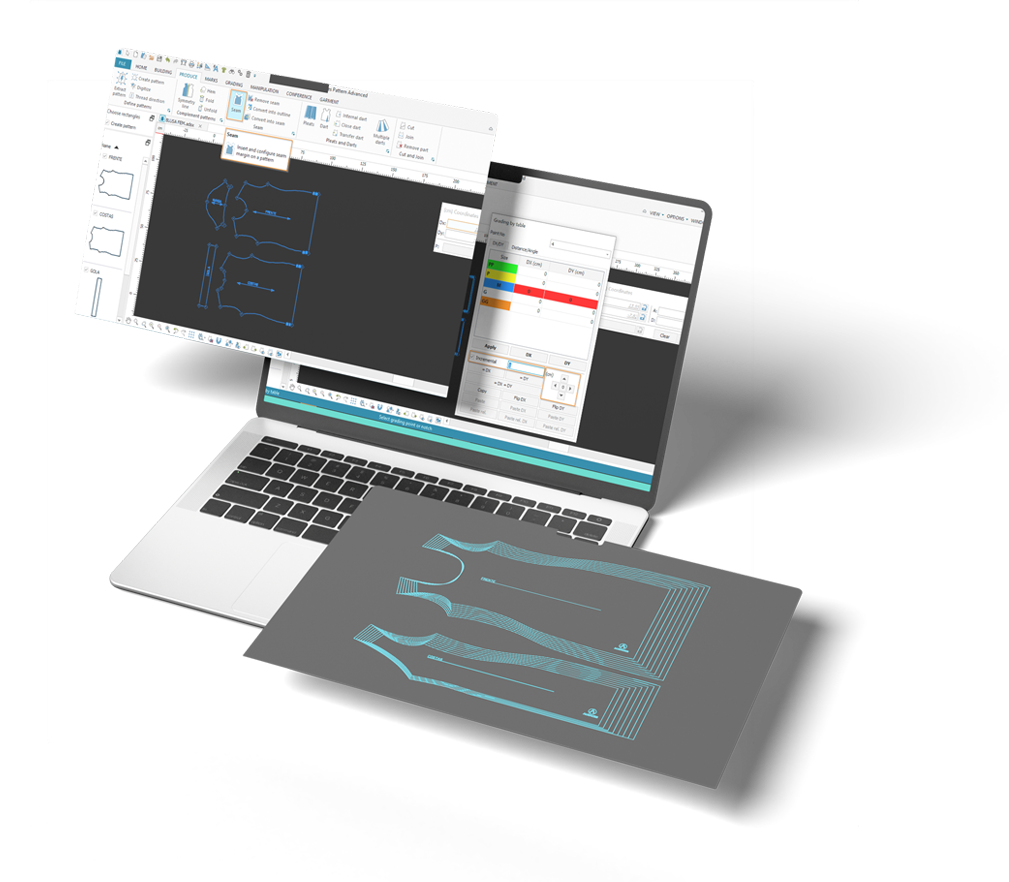Summary
- Industrial patterns are the backbone of efficient garment production. They provide precision and ensure quality in production.
- Mastering their use can transform your development and manufacturing processes, boosting profits.
- Leverage cutting-edge technology to enhance your fashion business. Start your free trial of Audaces360 today!
If you work in the fashion industry, you’ve likely encountered paper-based industrial patterns. They are a staple of traditional garment manufacturing.
However, manual patterns can be inaccurate. In addition, they take up space and can easily be mixed up, causing confusion.
To ensure consistent production, industrial patterns have gone digital. That’s why we’re here to share the benefits and importance of this shift.
Happy reading!
Sumário
What is the importance of pattern making in the industrial process?
Pattern making is a key step in the industrial production of clothing. They ensure that every piece is made with precision and consistency. Without them, it would be difficult to keep the production uniform.
Moreover, industrial patterns help save time and reduce waste. By using well-made patterns, manufacturers can cut fabric accurately and minimize errors.
It not only speeds up production but also lowers costs.
Their role in maintaining quality is also important. They guarantee that garments fit as intended and meet design specifications.
This is especially important when producing large quantities of clothing. A single mistake in a pattern can lead to costly errors across an entire batch.
In fashion businesses, precise patterns can turn creative ideas into high-quality garments. Mastering this process is a step toward achieving excellence in apparel production.
Learn more: Understand the importance of a pattern maker for fashion manufacturing
What is an industrial pattern?
An industrial pattern is a template used to create garments in mass production. It is the blueprint that guides the cutting of fabric.
Unlike handmade or custom patterns, industrial patterns focus on efficiency. Their goal is to optimize fabric usage and reduce waste.
This makes them ideal for factories and businesses that need to produce large quantities of garments quickly.
In apparel manufacturing, industrial patterns are the foundation of every collection. They turn a designer’s vision into a tangible product.
Learn more: Discover how to reduce costs in wholesale clothing production
What is the difference between an industrial pattern and a custom-made pattern?
An industrial pattern supports mass production. Their creation targets large quantities of the same garment.
These patterns focus on efficiency, ensuring consistency and reducing waste. Pattern makers develop them with standard measurements to fit a wide range of sizes.
A custom-made pattern, on the other hand, suits one specific person or design. It matches individual measurements or unique garment details.
It prioritizes personalization and precision over efficiency. They are common in couture or bespoke clothing.
Learn more: Explore the main types of patterns for fashion manufacturing
What does an industrial pattern maker do?

An industrial pattern maker creates templates for clothing production. They translate a designer’s ideas into precise patterns.
This kind of professional must use their skills to ensure the designs fit standard sizes and use fabric wisely. They also adjust patterns to different sizes, creating a full size range for production.
Industrial pattern makers often use digital tools. Software helps them draft, modify, and store patterns. It helps speed up the process and reduces errors.
Don’t let manual pattern-making hold you back. Discover how Audaces technology simplifies your workflow. Download our free guide today!
How is an industrial pattern made?
An industrial pattern starts with a design or concept. The pattern maker takes the designer’s sketches and measurements to create a template.
Next, the pattern maker drafts the pattern using digital software. They use precise measurements to create each piece of the garment. The pattern includes all the parts needed, such as sleeves, collars, and body panels.
Once the pattern is ready, the pattern maker tests it. They usually cut fabric using the pattern to check the fit and design.
To speed up the process, they can use 3D technology to test on a digital avatar instead of paper. This method improves efficiency by minimizing fabric waste.
If needed, they make changes to ensure the garment will look right in mass production.
Learn more: What is pattern design and how to create it from scratch?
How to use an industrial pattern to create new designs?
Creating new designs using an industrial pattern involves some steps. They ensure that the design is functional, accurate, and ready for mass production. Check it out!
1) Interpret technical specifications
The first step is to understand the specifications provided by the designer in the tech pack.
The pattern maker must interpret these details correctly to create a pattern that meets all the design’s requirements.
Once the specifications are clear, use them to draft the pattern. Consider factors like the fabric’s stretch and drape to ensure the garment will fit properly.
Accurate interpretation of technical specifications is crucial for creating a well-fitting and high-quality garment.
Learn more: Explore clothing pattern making techniques for your production
2) Identify size measurements
Identifying the right size measurements is key to creating an industrial pattern.
Pattern makers use standard size charts to determine the measurements for different sizes. You must adjust these measurements based on the design’s requirements.
Once you identify the measurements, apply them to the base pattern. It guarantees that each piece of the pattern fits within the specified size range.
This step is important for ensuring the garment will fit well across different body types.
3) Create a base pattern and make 2D changes
The base pattern serves as the foundation for all garment designs.
Pattern makers create the base pattern by drafting it from scratch or modifying an existing pattern. The base pattern includes the main pieces of the garment, such as the front, back, and sleeves.
Once the base is ready, you can make changes in 2D using digital tools to adjust it for any design you want.
These changes may include altering the neckline, sleeve length, or adding new details like pleats or pockets.
Learn more: Create a spiral pattern in 4 easy steps using your computer
4) Automatically scale pattern sizes

Scaling pattern sizes is an important step in industrial pattern making.
Once you have the base pattern, scale it to different sizes. This process ensures that the pattern fits a range of body types.
You can scale patterns manually or use software to automate the process. Automated grading tools make it faster and more accurate to create patterns in multiple sizes.
Modern solutions adjust the pattern proportions automatically while maintaining the correct fit.
5) Simulate the industrial pattern in 3D
Simulating the industrial pattern in 3D helps visualize how the garment will look once it’s ready.
Pattern makers use 3D software to test the digital version of the garment. This allows them to see how the fabric will behave and how the garment will fit.
The 3D simulation also helps identify potential design issues before production. For example, it can highlight areas where the fabric might bunch or stretch incorrectly.
It enables you to make changes before cutting the actual fabric.
Learn more: 5 reasons why pattern makers should start using 3D pattern
What is the best industrial pattern-making software?
The best industrial pattern-making software should help you create accurate patterns quickly and efficiently. It should offer a range of tools that make pattern design easier and more precise.
For over three decades, Audaces has been helping fashion businesses streamline their operations with innovative software solutions. Explore our pattern making products!
Partner with the industry leader to create your industrial patterns

Audaces Pattern
For pattern makers looking for excellence, Audaces Pattern is the next step. It ensures that industrial patterns achieve high levels of efficiency and precision.
With its versatile approach, it’s possible to develop high-quality pieces, regardless of complexity.
Refine every detail to perfection, ensuring that your creative vision translates into patterns. This advanced solution will assist you with all your pattern making endeavors!
Audaces 3D
Audaces 3D is ideal for pattern makers to bring creations to life in a 3D mannequin.
You can test your digital pattern before committing to a physical sample. Save time and resources by identifying issues early in the process.
With a range of tools and possibilities, this software transforms the development processes.
It enables you to shape your ideas directly in a digital space, gaining agility and quality in deliveries.
Discover Audaces360 and unlock a world of possibilities for fashion design and production!
FAQ
Pattern making is a key step in the industrial production of clothing. They ensure that every piece is made with precision and consistency.
An industrial pattern is a template used to create garments in mass production. It is the blueprint that guides the cutting of fabric.
An industrial pattern supports mass production. Their creation targets large quantities of the same garment. A custom-made pattern, on the other hand, suits one specific person or design.





